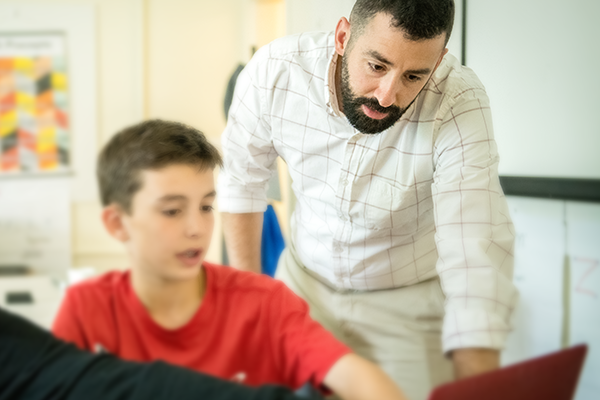At Beaver, we strive to provide opportunities for students to show us how smart they are. To do that, we embrace the fact our students all have different learning styles and an array of interests and passions. Every Beaver teacher is already fully on board with a “meet every student where they are” mindset, but there isn’t a playbook to explain how to do that in every area, for every lesson.
If we want to develop more coursework aimed at the success of all of our students, we need to start by investing in adding to our teachers’ toolboxes. Professional learning opportunities offer tangible experiences for our teachers to dig into how they can reach the needs of the greatest number of students at one time.
This year, because of generous donor support for our Professional Learning program through the Annual Fund, several members of the math department participated in a Universal Design for Learning (UDL) workshop together and were able to bring immediate tools to their students. Read more below.
By Tim O’Brien, Math Department Chair
Four members of the Math Department joined me for a Universal Design for Learning (UDL) workshop during the 2021-22 school year, which allowed us to all dive into the tools and collaborate on ways to bring what we learned back to Beaver as a department. Universal Design for Learning (UDL) presents a design process that coaches teachers in:
- Setting clear goals
- Anticipating barriers
- Designing options for students.
The workshop facilitators explained this design process using an analogy from architecture. Despite their ubiquity, we are now more aware that a set of stairs leading to the entry of a building needs reconsidering because they inherently prevent a population of people from accessing the building. So, we built a ramp. Problem solved, right? Well, UDL takes the perspective that the stairs were wrong in the first place–they were a “barrier” for access–and the accommodation of a ramp should never have been needed. The real solution is just a better design process from the onset by anticipating those barriers and creating options around them. This example directly connects to the classroom and the variability of needs of our students.
The use in the classroom really comes down to that third step of the process: options! UDL names three guidelines in this area for teachers to focus on options for …
Engagement: This means planning and designing how I will motivate and engage my students in learning. For me, that’s always providing context for the math. This context aims to pique interest by being relevant, to answer the adored “why do I need this?” question right off the bat, and thereby keep students intrinsically motivated to put in and maintain effort. In 6th grade math, with all of our fractions and decimals, we talk a lot about food: making it, sharing it, eating it.
Representation: This means planning and designing for how I will present information to my students. For me, that’s providing information to my 6th graders out loud, on the board, on Canvas, in a recorded video with captions, on a piece of paper–all at once, all at the same time–so students have the option for how they consume it.
Action & expression: This means planning and designing for how I will ask students to express what they know. For me, that’s providing a variety of forms of assessment. Yes, 6th graders still put pencil to paper on a good old-fashioned quiz, but they also create videos, build projects, write code, and engage in meaningful conversation about mathematical ideas. Sometimes I decide how students will express their understanding and sometimes they have the option to choose.
I was eager to try out a few new strategies in my class. Our last unit of the year in 6th grade focused on data and statistics. Specifically, ways to describe distribution (what’s typical in a set of data points) and measure variability (consistency of the data points). For that, the context for engagement was Beaver’s Wi-Fi. After a full year of school, students had their own opinions on the speed and reliability of the Wi-Fi. But, using the tools learned in this unit, we were able to draw conclusions based on mathematical evidence. Of course, I presented the information in a variety of ways, but we also learned about many different graphs and vocabulary for representing these ideas and practiced creating and interpreting these representations. Finally, students worked in pairs, chose a location in the building, ran 10-20 Wi-Fi speed tests for that location to create a real data set, then expressed their understanding of the math topics by creating a slide deck that summarized their findings and conclusions.

